 |
| Transformative Innovation in Education: A Playbook for Pragmatic Visionaries, by Graham Leicester, Keir Bloomer, and Denis Stewart (Triarchy Press, 2009, 52 pp., £10, $9.50 as an e-book). |
Educational and religious organizations excel at preserving the status quo. Blend religion and education in one institution and — well, let’s just say it takes a lot to coax things in a new direction.
After I came to Claremont School of Theology as president in 2006, I saw a need for organizational renewal and gave senior staff this little book to help lay a foundation for the task. I wanted us to begin on the same page — literally — as we worked together toward transformation. This required us to speak a common language.
Transformative Innovation in Education is a concise playbook that offers a fresh way of thinking about change in education. In a mere 52 pages, it introduces readers to three “horizons” that play a part in any program of intentional change.
First Horizon (H1) represents the system that preserves the status quo. When conditions begin to shift on the outside, H1 fights for survival on the inside because the status quo is familiar, comfortable, and nonthreatening.
Second Horizon (H2) represents a way of thinking that produces incremental steps forward, which result in innovations that begin to supersede H1. This horizon recognizes and values opportunity and entrepreneurship.
Third Horizon (H3) progresses to the next level of thinking. As new ideas gain acceptance, radical notions begin to appear. These are so far out on the fringe that they barely make sense to H1 or H2 thinking. They represent what the authors call the “long-term successor to business as usual, the product of radical innovation that introduces a completely new way of doing things.”
When we used this book at Claremont, we found it helped us identify the H1 characteristics of our school and to recognize challenges to the status quo. It sparked tactical responses and innovative adjustments to “business as usual.” Some administrators even began to categorize themselves and their colleagues into the three horizons and operated in sync with these categories. We now have a shared vocabulary for thinking realistically, strategically, and futuristically about our work in the world.
Managing significant, long-term change often feels like rebuilding an airplane while it’s flying. As the authors explain, “We need both to ‘keep the lights on’ today and to find a way of keeping them on a generation from now in very different circumstances.” I can think of nothing that is timelier for our current work in theological education.